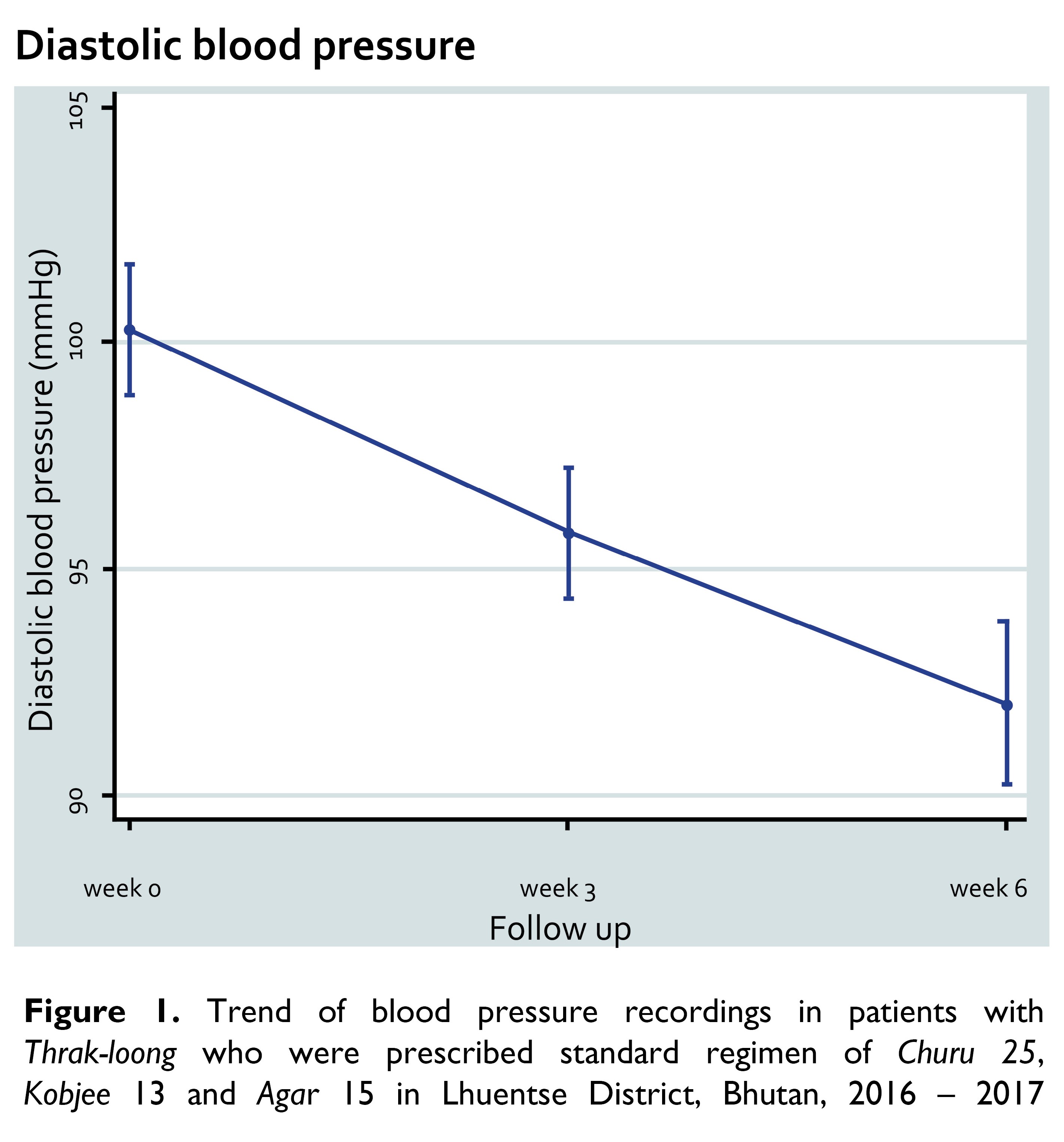Jigme Singye1 ,
Ngawang Gyeltshen2,
Kuenzang Chophel2, Kinzang Dechen3
,
Ngawang Gyeltshen2,
Kuenzang Chophel2, Kinzang Dechen3
1Centre for Bhutan and GNH Studies, Thimphu, Bhutan
2Traditional Medicine Unit, Central Regional Referral Hospital, Gelephu, Bhutan
3Department of Paediatrics, Eastern Regional Referral Hospital, Mongar, Bhutan
Corresponding author: Jigme Singye, Centre for Bhutan and GNH Studies, Thimphu, Bhutan.
Email: igmedrukyul@yahoo.com
DOI: https://doi.org/10.47811/bsj.0014050822
Dear Editor,
High blood pressure is a risk factor for many heart and blood vessel diseases, such as stroke, heart attacks, irregular heartbeats, and poor blood flow in the limbs and a leading cause of premature deaths [1]. Globally 7.6 million premature deaths and 92 million Disability-Adjusted Life Years were attributed to hypertension [2]. Nearly 54% of strokes and 47% of ischemic heart disease worldwide are attributable to hypertension [2, 3]. The number of people with hypertension in Bhutan has increased from 19,170 cases in 2019 to 25,770 cases in 2023 [4]. It is estimated that 35.7% of the population in the country in 2023 had hypertension [4].
Thrak-loong is the Sowa Rigpa term used for high blood pressure commonly known as hypertension in allopathic medicine [5]. In the past, Traditional Medicine professionals palpated the pulses of patients to diagnose blood pressure. The diagnosis is based on the clinical judgment of the professionals. However, these days whenever high blood pressure is suspected through a pulse reading, the patients are referred to an allopathic health professional for the confirmation. In Traditional Medicine practice, drugs are manufactured from herbal plants using herbal formula as recorded in the Subsequent Tantra [5]. Churu 25, Kobjee 13 and Agar 15 are routinely prescribed in the treatment of patients with Thrakloong.
We report on the effects of a standard regimen of Churu 25, Kobjee 13 and Agar 15 on blood pressure readings among 66 adults (48 males, mean age 56 ±17.48 years) in Lhuentse followed up between November 2016 and January 2017. Patients were administered a regimen of Churu 25 (three tablets in the morning), Kobjee 13 (three capsules in the afternoon), and Agar 15 (three tablets in the evening), each containing 500 mg. Sixty-one patients were followed up at Week 3 and 43 patients at Week 6. Blood pressure was measured at each visit by trained health professionals using a sphygmomanometer, with two readings taken five minutes apart [1]. This study was approved by the Research Ethics Board of Health, Ministry of Health, Bhutan. Of the 66 participants, 23 (34.84%) had been treated with conventional medication for high blood pressure a few years earlier but had stopped (Table 1).

One-way repeated measures ANOVA showed decrease in mean systolic and diastolic blood pressure over its time course, p < 0.0005 with the Greenhouse- Geisser correction. There was a reduction of 15.0 mmHg (95% CI 18.6 – 11.4 mmHg) in mean systolic blood pressure and 8.4 mmHg (95% CI 10.6 – 6.1 mmHg) in mean diastolic blood pressure, p < 0.001 (Figure 1).


Churu 25, Kobjee13 and Agar 15 constitutes multiple ingredients. One of the components, Choerospondias axillaris, is said to strengthen vital organs like the heart and kidneys, and plays a crucial role in regulating blood pressure by maintaining fluid balance [6]. Another component, Terminalia bellerica, helps lowering blood pressure by blocking calcium from entering cells and preventing its release from inside the cells [7].
It is important to ascertain the observations presented here and the current findings are not adequate for making clinical recommendations. It is recommended to study the safety and efficacy of these medications through a well-designed randomized controlled trial. This is particularly important in exploring traditional medicines as a solution in combatting the global burden of hypertension.
Acknowledgements
We express our gratitude to Ugyen Dorji (EMT), Taumo (Assistant Nurse), Sangay Dolma (Staff Nurse) at Lhuentse Hospital; Lethro (Menpa) at Tangamchu BHU-II, Lhuentse; and Yangchen Choden (Menpa) at Central Regional Referral Hospital, Gelephu for their support.
Declarations
Ethics approval and consent to participate
Ethics approval was obtained from the Research Ethics Board for Health,Ministry of Health (REBH/Approval/2016/077). Administrative approval was obtained from the Policy and Planning Division, Ministry of Health and Lhuentse hospital administrators. Informed written consent was obtained from each participant.
Consent for publication
Not applicable
Competing interests
JS is an editor of this journal and was blinded from all processes of peer review and editorial decision making leading to the acceptance of this article.
Funding
There was no funding for this article.
Availability of data materials
The data set is available from the corresponding author upon request.
Author contributions
Conceptualization, data curation, methodology, resources, review and editing, analysis, writing original draft, validation: JS
Data collection, Data entry: NG, KC, KD
Validation: NG, KC
Received: 09 April, 2024 Accepted: 23 October, 2024 Published online: 11 November, 2024
References
- Kaneko H, Yano Y, Itoh H, Morita K, Kiriyama H, Kamon T, et al. Association of Blood Pressure Classification Using the 2017 American College of Cardiology/ American Heart Association Blood Pressure Guideline with Risk of Heart Failure and Atrial Fibrillation. Circulation. 2021;143: 2244 – 2253. doi:10.1161/CIRCULATIONAHA.120.052624
- Lawes CM, Hoorn SV, Rodgers A. Global burden of blood-pressure-related disease, 2001. The Lancet. 2008 May;371(9623):1513–8. doi:10.1016/ s0140-6736(08)60655-8
- World Health Organization. Global report on hypertension. Universitas Nusantara PGRI Kediri. 2023.
- Ministry of Health. Annual Health Bulletin 2023. Ministry of Health, Royal Government of Bhutan, Thimphu. 2023.
- Goenpo YY. So-Rig Jued-Zhi Drel-Chen Drang Song Zhelung I. 1st ed. Namgyal TT, editor. Dharamsala, India: Mentsikhang, Dharamsala; 2000.
- Rai M, Bhattarai S, Feitosa CM. Wild Plants as a Treasure of Natural Healers. Mahendra Rai SB, editor. Wild Plants. CRC Press; 2020. doi:10.1201/9781003020134-2
- Khan AU, Gilani AH. Pharmacodynamic evaluation of Terminalia bellerica for its antihypertensive effect. J Food Drug Anal. 2008;16: 6–14. doi:10.38212/2224-6614.2355